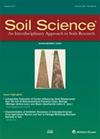Synergy between compost and cover crops in a Mediterranean row crop system leads to increased subsoil carbon storage
4区 农林科学
Q2 Agricultural and Biological Sciences
引用次数: 3
Abstract
Abstract. Subsoil carbon (C) stocks are a prime target for efforts to increase soil C storage for climate change mitigation. However, subsoil C dynamics are not well understood, especially in soils under long-term intensive agricultural management. We compared subsoil C storage and soil organic matter (SOM) composition in tomato–corn rotations after 25 years of differing C and nutrient management in the California Central Valley: CONV (mineral fertilizer), CONV+WCC (mineral fertilizer and cover crops), and ORG (composted poultry manure and cover crops). The cover crop mix used in these systems is a mix of oat (Avena sativa L.), faba bean (Vicia faba L.), and hairy vetch (Vicia villosa Roth). Our results showed a ∼19 Mg ha−1 increase in soil organic C (SOC) stocks down to 1 m under ORG systems, no significant SOC increases under CONV+WCC or CONV systems, and an increased abundance of carboxyl-rich C in the subsoil (60–100 cm) horizons of ORG and CONV+WCC systems. Our results show the potential for increased subsoil C storage with compost and cover crop amendments in tilled agricultural systems and identify potential pathways for increasing C transport and storage in subsoil layers.在地中海行作作物系统中,堆肥和覆盖作物之间的协同作用导致地下碳储量增加
摘要土壤碳(C)储量是增加土壤碳储量以减缓气候变化的主要目标。然而,对地下土壤C的动态,特别是在长期集约化农业管理下的土壤中,还不是很清楚。在加利福尼亚中央谷地,采用不同的碳和养分管理方式:CONV(矿物肥)、CONV+WCC(矿物肥和覆盖作物)和ORG(堆肥禽粪和覆盖作物),比较了25年后番茄-玉米轮作的地下碳储量和土壤有机质(SOM)组成。在这些系统中使用的覆盖作物混合是燕麦(Avena sativa L.),蚕豆(Vicia faba L.)和毛豌豆(Vicia villosa Roth)的混合物。结果表明,在ORG系统下,土壤有机碳(SOC)储量在1 m以下增加了~ 19 Mg ha−1,而在CONV+WCC或CONV系统下,SOC没有显著增加,ORG和CONV+WCC系统的底土(60-100 cm)富含羧基C的丰度增加。我们的研究结果表明,在耕作的农业系统中,堆肥和覆盖作物改良有可能增加地下土壤C的储存,并确定了增加地下土壤C运输和储存的潜在途径。
本文章由计算机程序翻译,如有差异,请以英文原文为准。
求助全文
约1分钟内获得全文
求助全文
来源期刊

Soil Science
农林科学-土壤科学
CiteScore
2.70
自引率
0.00%
发文量
0
审稿时长
4.4 months
期刊介绍:
Cessation.Soil Science satisfies the professional needs of all scientists and laboratory personnel involved in soil and plant research by publishing primary research reports and critical reviews of basic and applied soil science, especially as it relates to soil and plant studies and general environmental soil science.
Each month, Soil Science presents authoritative research articles from an impressive array of discipline: soil chemistry and biochemistry, physics, fertility and nutrition, soil genesis and morphology, soil microbiology and mineralogy. Of immediate relevance to soil scientists-both industrial and academic-this unique publication also has long-range value for agronomists and environmental scientists.
 求助内容:
求助内容: 应助结果提醒方式:
应助结果提醒方式:


